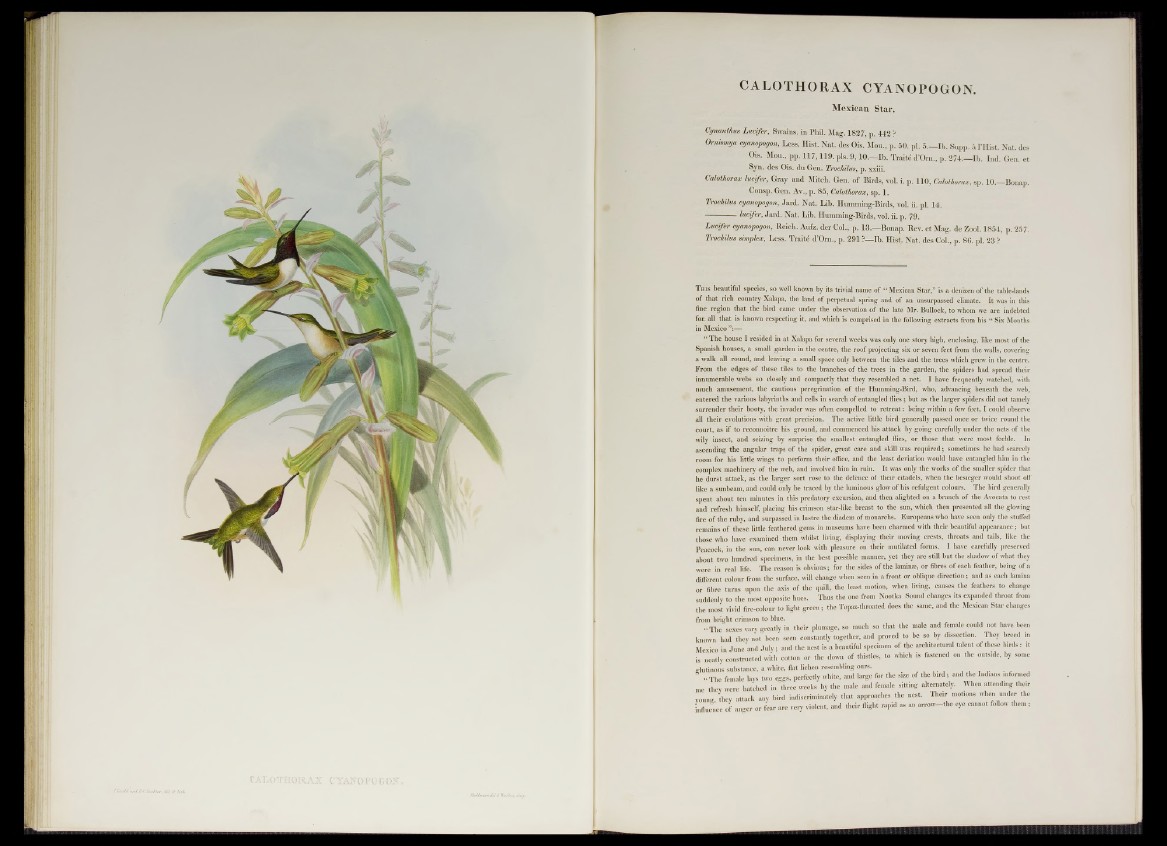
CALOTHORAX CYANOPOGON.
Mexican Star.
Cynantim Lucifer, Swains, in Phil. Mag. 1827, p. 442 ?
Omismya cyanopogon, Less. Hist. Nat. des Ois. Mou., p. 50. pl. 5.—Ib. Supp. à l'Hist. Nat. des
Ois. Mou., pp. 117,119. pis. 9 ,1 0 .—Ib. Traité d'Om., p. 274.—Ib. Ind. Gen. et
Syn. des Ois. du Gen. Trochilm, p. xxiii.
Calotkorax lucifer, Gray and Mitch. Gen. of Birds, vol. i. p. 110, Calothmax, sp. 10.—Bonap.
Consp. Gen. Av., p. 85, Calothoracc, sp. 1.
Trochilm cyanopogon, Jard. Nat. Lib. Humming-Birds, vol. ii. pi. 14.
----------- - lucifer, Jard. Nat. Lib. Humming-Birds, vol. ii. p. 79.
Lucifer cyanopogon, Reich. Aufz. der Col., p. 13.—Bonap. Rev. et Mag. de Zool. 1854, p. 257.
Trochilm simplex, Less. Traité d’Om., p. 291 ?— Ib. Hist, Nat. des Col., p. 86. pi. 23 ?
T his beautiful species, so well known by its trivial name of “Mexican Star,” is a denizen of the table-lands
of that rich country Xalapa, the land of perpetual spring and of an unsurpassed climate. It was in this
fine region that the bird came under the observation of the late Mr. Bullock, to whom we are indebted
foe. all that is known respecting it, and which is comprised in the following extracts from his “ Six Months
in Mexico”:—
“ The house I resided in at Xalapa for several weeks was only one story high, enclosing, like most of the
Spanish houses, a small garden in the centre, the roof projecting six or seven feet from the walls, covering
a walk all round, and leaving a small space only between the tiles and the trees which grew in the centre.
From the edges of these tiles to the branches of the trees in the garden, the spiders had spread their
innumerable webs so closely and compactly that they resembled a net. I have frequently watched, with
much amusement, the cautious peregrination of the Humming-Bird, who, advancing beneath the web,
entered the various labyrinths and cells in search of entangled dies; but as the larger spiders did not tamely
surrender their booty, the invader was often compelled to retreat: being within a few feet, I could observe
all their evolutions with great precision. The active little bird generally passed once or twice round the
court, as if to reconnoitre his ground, and commenced his attack by going carefully under the nets of the
wily insect, and seizing by surprise the smallest entangled flies, or those that were most feeble. In
ascending the angular traps of the spider, great care and skill was required; sometimes he had scarcely
room for his little wings to perform their office, and the least deviation would have entangled him in the
complex machinery of the web, and involved him in ruin. It was only the works of the smaller spider that
he durst attack, as the larger sort rose to the defence of their citadels, when the besieger would shoot off
like a sunbeam, and could only he traced by the luminous glow of his refulgent colours. The bird generally
spent about ten minutes in this predatory excursion, and then alighted on a branch of the Avocata to rest
and refresh himself, placing his crimson star-like breast to the sun, which then presented all the glowing
fire of the ruby, and surpassed in lustre the diadem of monarchs. Europeans who have seen only the stuffed
remains of these little feathered gems in museums have been charmed with their beautiful appearance; but
those who have examined them whilst living, displaying their moving crests, throats and tails, like the
Peacock, in the sun, can never look with pleasure on their mutilated forms. I have carefully preserved
about two hundred specimens, in the best possible manner, yet they are still but the shadow of what they
were in real life. The reason is obvious; for the sides of the laminae, or fibres of each feather, being of a
different colour from the surface, will change when seen in a front or oblique direction; and as each lamina
or fibre turns upon the axis of the quill, the least motion, when living, causes the feathers to change
suddenly to the most opposite hues. Thus the one from Nootka Sound changes its expanded throat from
the most vivid fire-colour to light green; the Topaz-throated does the same, and the Mexican Star changes
from bright crimson to blue.
“ The sexes vary greatly in their plumage, so much so that the male and female could not have been
known had they not been seen constantly together, and proved to be so by dissection. They breed in
Mexico in June and July; and the nest is a beautiful specimen of the architectural talent of these birds: it
is neatly constructed with cotton or the down of thistles, to which is fastened on the outside, by some
glutinous substance, a white, flat lichen resembling ours. | H H H I
“ The female lays two eggs, perfectly white, and large for the size of the bird; and the Indians informed
me they were hatched in three weeks by the male and female sitting alternately. When attending their
vouno- they attack any bird indiscriminately that approaches the nest. Their motions when under the
influence of anger or fear are very violent, and their flight rapid as an arrow-the eye cannot follow them;